Complete Guide on How to Install Dolibarr using LAMP Stack on AlmaLinux 8
In today's digital era, Dolibarr ERP/CRM has become one of the most widely used open-source software solutions by small to medium-sized companies to manage their businesses. By combining Enterprise Resource Planning (ERP) and Customer Relationship Management (CRM) in one platform, Dolibarr simplifies data, finances, customers, inventory, and projects.
In this guide, we'll cover in detail how to install Dolibarr using the LAMP Stack on AlmaLinux 8. This complete guide covers everything from server preparation, component installation, database configuration, and the final step of running Dolibarr in a web browser.
If you want optimal results without the hassle of managing your own installation, don't hesitate to contact Focusnic, a professional provider of server installation services and cloud VPS solutions ready to assist you with your needs.
Prerequisites
- Full root access
- Domain (optional)
- Basic Linux Command Line
Preparation
Make sure the firewall and SELinux have been adjusted or temporarily disabled if you want to avoid problems during the initial installation.
Before starting the Shopware installation, make sure your AlmaLinux 8 server is up to date and ready to install the LAMP Stack (Linux, Apache, MariaDB, PHP).
dnf update -y
dnf install epel-release -y
Install Apache
Apache is a reliable web server and is widely used in production environments. To install it, run the following command:
dnf install httpd -y
Once the installation is complete, enable and start the Apache service with the following command:
systemctl enable --now httpd
To allow access to the server via HTTP and HTTPS, allow the firewall:
firewall-cmd --permanent --add-service={http,https}
firewall-cmd --reload
Install PHP
PHP (Hypertext Preprocessor) is a server-side programming language that is crucial in this stack. We will install PHP 8 from the Remi Repository to use the latest version of PHP.
Run the following command to install the Remi Repository:
dnf install -y https://rpms.remirepo.net/enterprise/remi-release-8.rpm
Then list the available PHP using the following command:
dnf module list php
Output example:
AlmaLinux 8 - AppStream
Name Stream Profiles Summary
php 7.2 [d] common [d], devel, minimal PHP scripting language
php 7.3 common [d], devel, minimal PHP scripting language
php 7.4 common [d], devel, minimal PHP scripting language
php 8.0 common [d], devel, minimal PHP scripting language
php 8.2 common [d], devel, minimal PHP scripting language
Remi's Modular repository for Enterprise Linux 8 - x86_64
Name Stream Profiles Summary
php remi-7.2 common [d], devel, minimal PHP scripting language
php remi-7.3 common [d], devel, minimal PHP scripting language
php remi-7.4 common [d], devel, minimal PHP scripting language
php remi-8.0 common [d], devel, minimal PHP scripting language
php remi-8.1 common [d], devel, minimal PHP scripting language
php remi-8.2 common [d], devel, minimal PHP scripting language
php remi-8.3 common [d], devel, minimal PHP scripting language
php remi-8.4 common [d], devel, minimal PHP scripting language
Hint: [d]efault, [e]nabled, [x]disabled, [i]nstalled
Enable the desired PHP module version. For example, for PHP 8.4, run the following command:
dnf module reset php -y
dnf module enable php:remi-8.4 -y
Once the repository is active, we can proceed with installing PHP along with the commonly used essential modules:
dnf install -y php php-cli php-common php-mysqlnd php-fpm php-opcache php-gd php-curl php-mbstring php-xml php-json php-soap php-bcmath php-zip php-intl php-posix php-imap php-ldap
Check the installed PHP version with the following command:
php -v
Install MariaDB
MariaDB is a replacement for MySQL and is compatible with MySQL-based applications. Run the following command to install it:
dnf module list mariadb
Output example:
AlmaLinux 8 - AppStream
Name Stream Profiles Summary
mariadb 10.3 [d] client, galera, server [d] MariaDB Module
mariadb 10.5 client, galera, server [d] MariaDB Module
mariadb 10.11 client, galera, server [d] MariaDB Module
Hint: [d]efault, [e]nabled, [x]disabled, [i]nstalled
The output above shows that the default version of MariaDB is 10.11 (the latest version from the OS). However, we'll use MariaDB version 11.4.7 using the official repository at https://mariadb.org/download/ and then reset MariaDB to remove it from the OS's default repository:
dnf module reset mariadb
Run the following command to add the MariaDB version 11.4.7 repository:
nano /etc/yum.repos.d/MariaDB.repo
Add the following parameters:
# MariaDB 11.4 RedHatEnterpriseLinux repository list - created 2025-07-31 14:04 UTC
# https://mariadb.org/download/
[mariadb]
name = MariaDB
# rpm.mariadb.org is a dynamic mirror if your preferred mirror goes offline. See https://mariadb.org/mirrorbits/ for details.
# baseurl = https://rpm.mariadb.org/11.4/rhel/$releasever/$basearch
baseurl = https://mirror.its.dal.ca/mariadb/yum/11.4/rhel/$releasever/$basearch
module_hotfixes = 1
# gpgkey = https://rpm.mariadb.org/RPM-GPG-KEY-MariaDB
gpgkey = https://mirror.its.dal.ca/mariadb/yum/RPM-GPG-KEY-MariaDB
gpgcheck = 1
Then run the following command to install MariaDB:
dnf install MariaDB-server MariaDB-client
Enable and activate the MariaDB service:
systemctl enable --now mariadb
systemctl status mariadb
Before using it for production or testing, it is best to secure the MariaDB installation first by running the following command:
mariadb-secure-installation
Then follow the instructions that appear:
- Enter current password for root (enter for none) → [ENTER]
- Switch to unix_socket authentication → Y
- Change the root password? → Y
- Remove anonymous users? → Y
- Disallow root login remotely? Y
- Remove test database and access to it? Y
- Reload privilege tables now? Y
Install Dolibarr
Before installing Dolibarr, we'll first create a virtual host and database (to store Dolibarr's content, configuration, and structure). Run the following command to create a virtual host:
Make sure you're using a valid domain (FQDN) and that the DNS A record is pointed to the server IP address used on your server.
nano /etc/httpd/conf.d/focusnic.biz.id.conf
Fill in the following parameters:
<VirtualHost *:80>
ServerAdmin webmaster@focusnic.biz.id
ServerName focusnic.biz.id
ServerAlias www.focusnic.biz.id
DocumentRoot /var/www/focusnic.biz.id/public_html
<Directory /var/www/focusnic.biz.id>
AllowOverride All
Require all granted
</Directory>
ErrorLog /var/log/httpd/focusnic.biz.id-error.log
CustomLog /var/log/httpd/focusnic.biz.id-access.log combined
</VirtualHost>
Then create a directory on the virtualhost above:
mkdir -p /var/www/focusnic.biz.id/public_html
Restart Apache to save changes:
apachectl configtest
systemctl restart httpd
Change the php.ini configuration with the following command:
nano /etc/php.ini
Adjust according to the following parameters:
max_execution_time = 180
max_input_time = 180
memory_limit = 256M
post_max_size = 50M
upload_max_filesize = 50M
Then restart php-fpm to save the changes with the following command:
systemctl restart php-fpm
Create a database by running the following command:
mariadb
Then run the following command to create a database, user, and password:
create database dolibarr_db;
create user 'dolibarr_user'@'localhost' identified by 'yjLmBXOWDcOZFHh4';
grant all on dolibarr_db.* to 'dolibarr_user'@'localhost';
flush privileges;
quit;
Download the Dolibarr file and place it in the appropriate directory of the virtualhost:
cd /var/www/focusnic.biz.id/public_html
wget https://github.com/Dolibarr/dolibarr/archive/refs/tags/21.0.3.zip
unzip 21.0.3.zip
mv dolibarr-21.0.3/htdocs/* /var/www/focusnic.biz.id/public_html
mv dolibarr-21.0.3/scripts /var/www/focusnic.biz.id
Adjust permissions:
find /var/www/focusnic.biz.id/public_html -type f -exec chmod 644 {} \;
find /var/www/focusnic.biz.id/public_html -type d -exec chmod 755 {} \;
chown -R apache:apache /var/www/focusnic.biz.id
Access the Dolibarr installation in the browser by typing the domain name or IP.
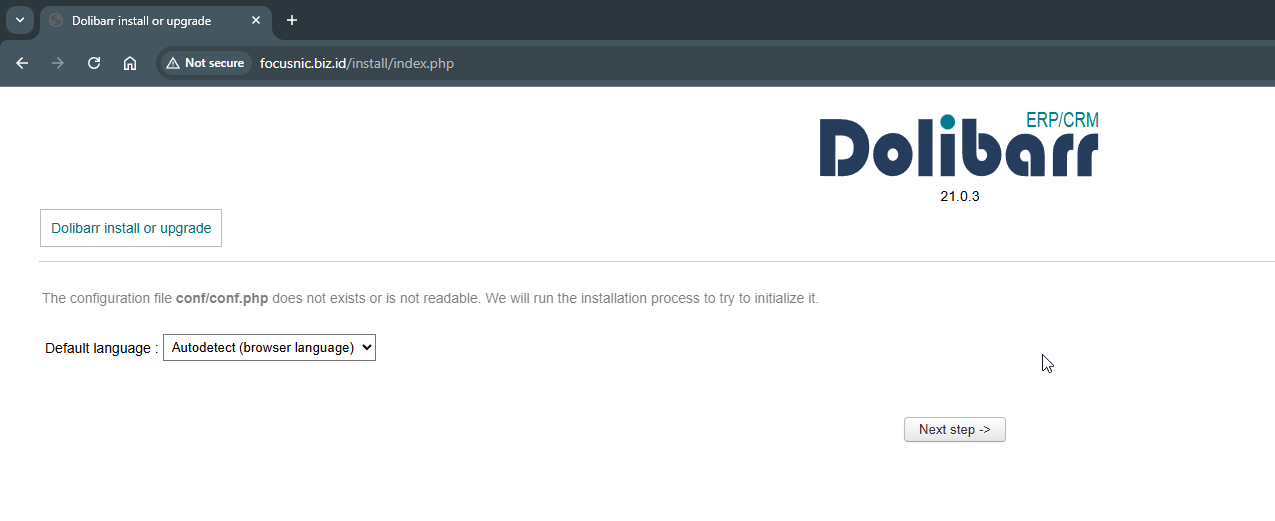
Dolibarr will perform a system check before continuing the installation, make sure it is fulfilled.
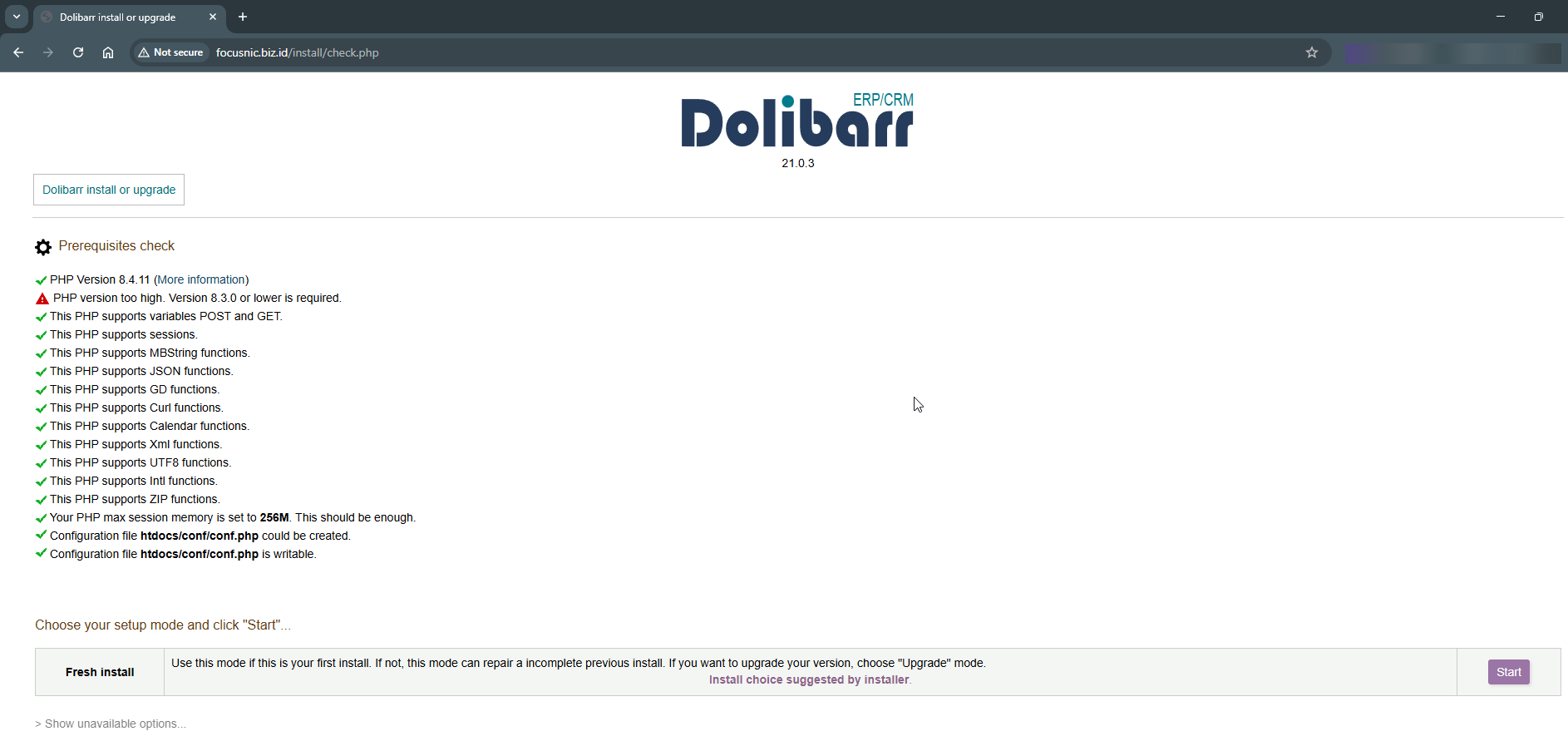
Then setup the Dolibarr installation directory, URL, and also the database.
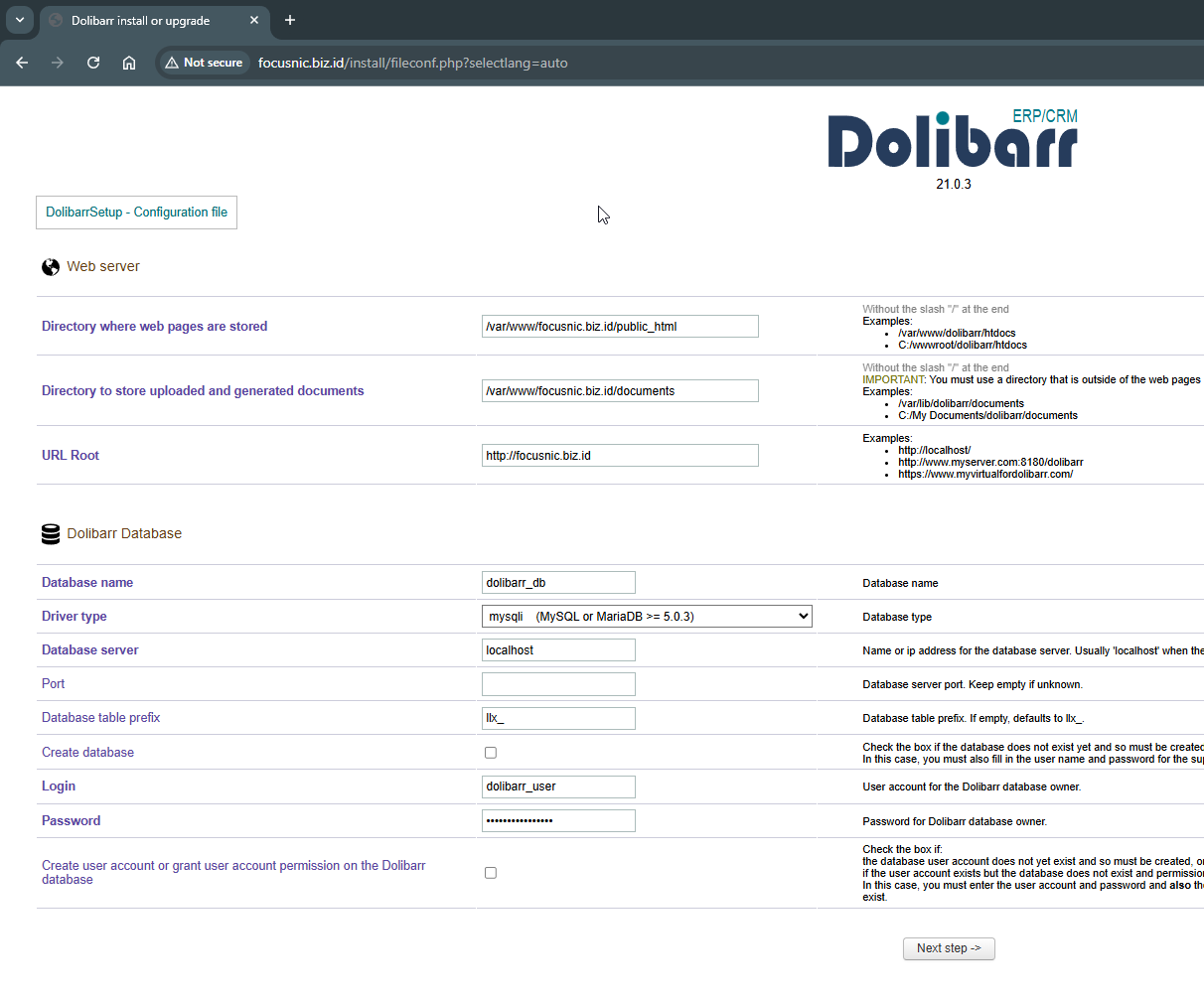
Install Dolibarr

Create an admin user for Dolibarr
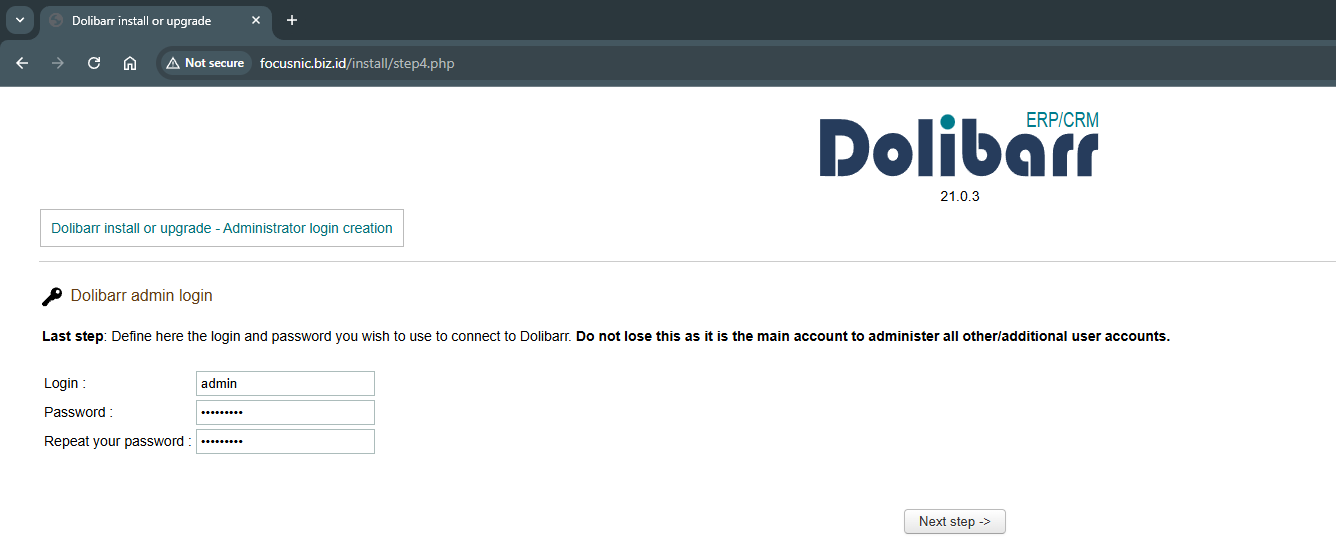
Access the Dolibarr admin page via http://$DOMAIN/admin/
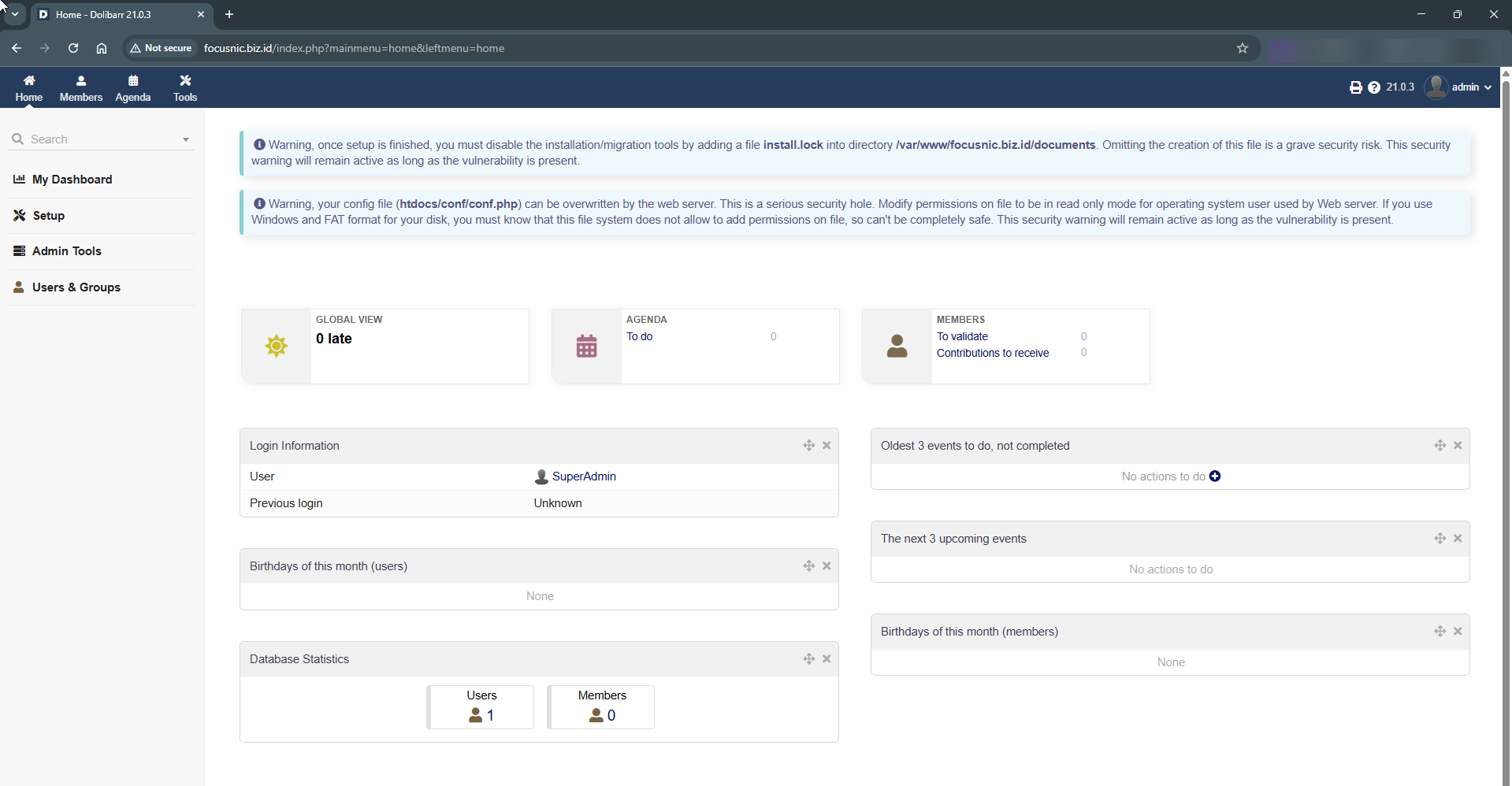
Troubleshooting
- Dolibarr Page is Blank or Error 500
The PHP module is incomplete or the file permissions are incorrect. Ensure all PHP extensions, such as php-mysqlnd, php-mbstring, php-xml, and php-intl, are installed. Then, run the following command to adjust the permissions:
find /var/www/focusnic.biz.id/public_html -type f -exec chmod 644 {} \;
find /var/www/focusnic.biz.id/public_html -type d -exec chmod 755 {} \;
chown -R apache:apache /var/www/focusnic.biz.id
- Database Connection Failed
The username, password, or database name is incorrect. Then grant the appropriate privileges:
mariadb
grant all on dolibarr_db.* to 'dolibarr_user'@'localhost';
Login to the database to test the user that has been created:
mariadb -u dolibarr_user -p
Conclusion
Through this guide, we have successfully covered in detail how to install Dolibarr using the LAMP Stack on AlmaLinux 8. This includes server preparation, installation of Apache, MariaDB, and PHP, and Dolibarr configuration via the web interface. With the right steps, Dolibarr can be an efficient, cost-effective, and flexible ERP/CRM solution for your business. However, server management requires special attention in terms of security, performance optimization, and long-term maintenance.
If you want a hassle-free installation and full support in managing your business server, Focusnic is your trusted partner, providing professional server installation services and cloud VPS services.
Q: Is Dolibarr free to use?
A: Yes, Dolibarr is open-source and free to use. You just need to set up a server to run it.
Q: What's the difference between MariaDB and MySQL in a Dolibarr installation?
A: MariaDB is a compatible fork of MySQL and is more commonly used on modern servers. Dolibarr supports both, but MariaDB is recommended for AlmaLinux 8.
Q: Can Dolibarr run over HTTPS/SSL?
A: Yes, Dolibarr is highly recommended to run over HTTPS. You can use Let's Encrypt for a free SSL certificate.
Further References: